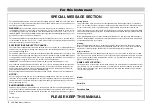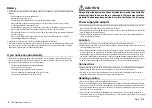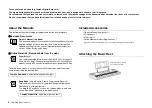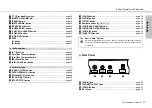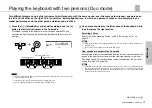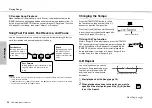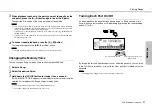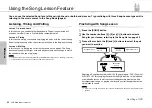
PSR-E360 Owner’s Manual
7
Always turn the power off when the instrument is not in use.
Even when the [
] (Standby/On) switch is in standby status (display is off), electricity is still flowing to
the instrument at the minimum level.
When you are not using the instrument for a long time, make sure you unplug the power cord from the wall
AC outlet.
Make sure to discard used batteries according to local regulations.
DMI-7
3/3
(bottom_en_01)
NOTICE
To avoid the possibility of malfunction/ damage to the product, damage to data, or damage to other
property, follow the notices below.
Handling
• Do not use the instrument in the vicinity of a TV, radio, stereo equipment, mobile phone, or other electric
devices. Otherwise, the instrument, TV, or radio may generate noise.
• When you use the instrument along with an app on your smart device such as a smartphone or tablet,
we recommend that you enable “Airplane Mode” on that device in order to avoid noise caused by
communication.
• Do not expose the instrument to excessive dust or vibrations, or extreme cold or heat (such as in direct
sunlight, near a heater, or in a car during the day) to prevent the possibility of panel disfiguration,
damage to the internal components or unstable operation. (Verified operating temperature range: 5° –
40°C, or 41° – 104°F.)
• Do not place vinyl, plastic or rubber objects on the instrument, since this might discolor the panel or
keyboard.
Maintenance
• When cleaning the instrument, use a soft cloth. Do not use paint thinners, solvents, alcohol, cleaning
fluids, or chemical-impregnated wiping cloths.
Saving data
• Some of the data of this instrument (page 31) are retained when the power is turned off. However, the
saved data may be lost due to some failure, an operation mistake, etc.
Information
About copyrights
• Copying of the commercially available musical data including but not limited to MIDI data and/or audio
data is strictly prohibited except for your personal use.
• This product incorporates and bundles contents in which Yamaha owns copyrights or with respect to
which Yamaha has license to use others’ copyrights. Due to copyright laws and other relevant laws, you
are NOT allowed to distribute media in which these contents are saved or recorded and remain virtually
the same or very similar to those in the product.
* The contents described above include a computer program, Accompaniment Style data, MIDI data,
WAVE data, voice recording data, a score, score data, etc.
* You are allowed to distribute medium in which your performance or music production using these
contents is recorded, and the permission of Yamaha Corporation is not required in such cases.
About functions/data bundled with the instrument
• Some of the preset songs have been edited for length or arrangement, and may not be exactly the same
as the original.
About this manual
• The illustrations and LCD screens as shown in this manual are for instructional purposes only, and may
appear somewhat different from those on your instrument.
• The letters at the end of the model name (“DW” or “MA”) are color information of the instrument. For
example, “DW” indicates “Dark Walnut”, and “MA” indicates “Maple.” Since they simply indicate the
color, these letters are omitted in this manual.
• The company names and product names in this manual are the trademarks or registered trademarks of
their respective companies.
Yamaha cannot be held responsible for damage caused by improper use or modifications to the
instrument, or data that is lost or destroyed.
The model number, serial number,
power requirements, etc., may be
found on or near the name plate,
which is at the bottom of the unit.
You should note this serial number in
the space provided below and retain
this manual as a permanent record
of your purchase to aid identification
in the event of theft.
Model No.
Serial No.


